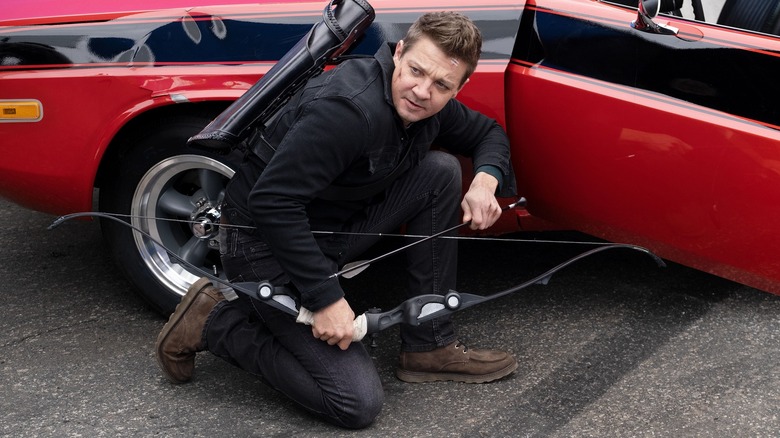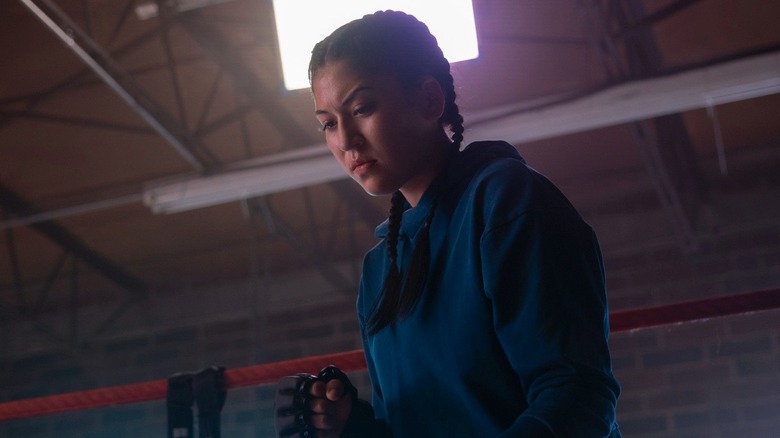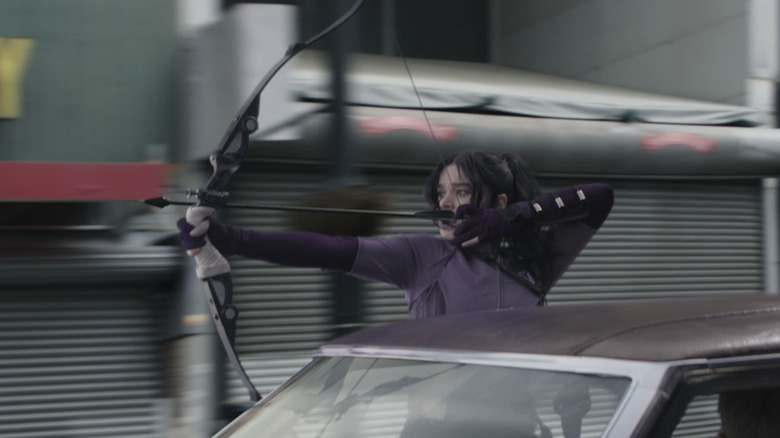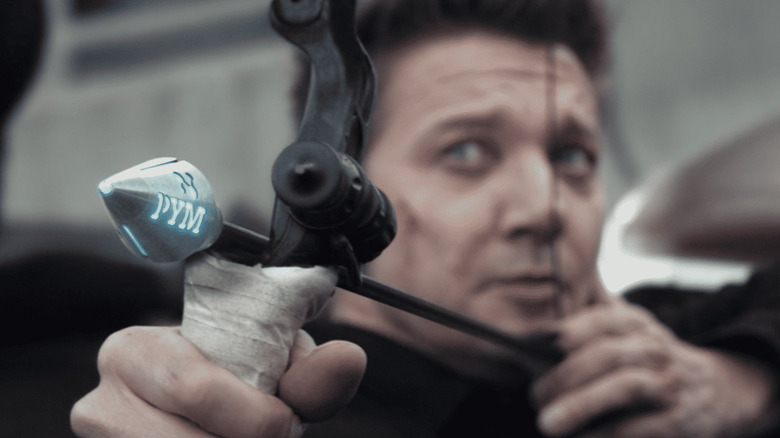Hawkeye Directors Bert & Bertie Reveal The Creative Collaboration Of A Marvel Project [Interview]
The directing duo Amber Templemore-Finlayson and Katie Ellwood, better known as Bert & Bertie, are two of the strong voices behind Marvel's new "Hawkeye" series. The directors of "Troop Zero" are known for their more low-key filmmaking, and that sense of grounding brings a fresh flavor to the latest Marvel Cinematic Universe series on Disney+. It's not just CGI fighting CGI — it's characters running in the streets, in real environments, fighting real people.
The directors helmed three episodes of the series, including last week's "Echoes," in which audiences got a meaningful introduction to Maya Lopez (aka Echo), played by Alaqua Cox. In a matter of minutes, the filmmakers and the actress make Echo a captivating force in the MCU. Episode three also kicked things up a few notches in the action department, especially with a car chase featuring one of the rare long takes in a Marvel production.
Recently, we sat down with Bert & Bertie to talk about crafting that car chase, introducing Echo, and a helpful note they received from Marvel president Kevin Feige.
"You have to watch."
Let's start with the opening of Echo. It's like a great short film.
Bert: Well, it's always a gift to be given an emotional opening to an episode. And Maya, this character, obviously runs deep and she's had this childhood where she's had to survive in a way. As an adult, that's what she's still doing. She's got these instincts that have been embedded into her, by her father from that very first moment when he says, "You have to watch." And that's something we wanted to take into a technique. I wish we had more time to do it even more about how she's sees the world and the detail that she sees, and that's her superpower. We wanted to focus on it as a strength rather than something that was holding her back.
Did you lose any scenes or beats?
Bertie: We had some extra little snippets in there, but what happens is you shoot them and then you realize what's really serving her story. I think after the great bigness of episode one and two to really bring it back to just that, which is intimate and just feels almost like Maya's perspective of the world, because she's a watcher. And so for instance, I mean, there were a few snippets that were lost, but also we did some wide scenes in the dojo when she's going up against the big kid and we realized that, that wasn't her perspective and we wanted to keep everything from her point of view. It tells you so much more about the character, so that was one change we've shifted in the edit.
You have the intimate opening, but then you have that big car chase with many moving pieces. Where'd you start crafting that sequence?
Bert: Oh my God. Do you know what? The script is always your roadmap, isn't it? But what we always kept at the heart of this whole series, it's a very grounded story. How could we keep it about their relationship rather than, oh, how smart can we be or how big can we make this? Because you know with Marvel, you can go off planet, you can do anything. But actually, their relationship is what's the core; that buddy, mentor/mentee relationship. So for us, keeping that at its heart, it's like, "Well, okay, we keep the camera with them." And then from there, it was just this natural progression to, "Let's keep it about the comedy. Let's keep it about the characters and let's keep the audience in the car chase." That was our starting point and everything comes out of that. Everything comes out of character. So if you have a certain camera move, it's because it relates to character and it relates to relationship. And so, that's where we get to the heart of this whole huge sequence was them.
Bertie: Yeah, we were outside that car until Kate got out of the side of the car, so that was a wonderful journey to, "Can we just stay in the car with them and choreograph the action around them in this ever-revolving camera?" It was a journey, because in Marvel, they've tried some oners in car chases before. And Kevin was saying, "Yeah, they've never made the cut, though, ladies." And we're like, "Can we just pre-vis it? Can we just show you?" And we showed them and they were like, "That's really cool, but how are you going to achieve that?" And we're like, "Can we just test it?" And then we tested it and it was great. We went all the way through and Kevin came down for the shoot and he was like, "Yeah, I think this might be the one that stays in," and it did.
Good balance of practical and CGI there, too.
Bertie: It's challenging, isn't it? There was a point at what we wanted to achieve in New York, it was just looking unlikely. And there was a point at which we were thinking the whole thing was going to be on a stage in blue screen. And then we looked around Atlanta and we were like, "So many of these streets could be some slightly nondescript street in Brooklyn, just with a skyline." And from the moment we made that decision, we start in a very real world and that whole oner and everything up until the bridge, one or two shots here and there is shot on the streets with adornments to make it feel more like New York. And that really set the grounding and gave the VFX guys, it gave them the right lighting, it gave them the right look of the world, and so then we were just replicating it.
Bert: And what it gives is, it brings you back to what they at least did in the '70s when they did it for real. Do you know what I mean? It gives it a real tactile, emotional, real-world feeling, which is what this whole series is about.
"More Christmas."
I really enjoyed Barton in his Charles Barkley moment of, "I am not a role model," at the diner. On the flip-side of the action, how is shooting those walk and talk and diner scenes?
Bert: It's such a relief. You can totally sit down and no one punches anyone. It's great. And also, these two extraordinary actors, they have such a high caliber and just to have them talking to each other, it's such a gift because they enjoy it too. We like to let them just run with it. They get to find all the ebb and the flow in the conversation. Obviously, the writing's so good, so it's just a joy. You just call action and let them be their incredible selves.
Say for the uncle, how much did you debate how much to show?
Bert: I can't remember. Do you, Bertie? I can't remember.
Bertie: I guess I don't really remember the scene we're actually talking about.
[Laughs] I'll leave it at that. Since the scale of the show is pretty big, does it feel like shooting a movie?
Bertie: Well, like shooting the biggest movie we'd ever shot. We were shooting three-hour long pieces. I think that's what Marvel are doing brilliantly with their TV shows. They consider them six-hour movies with this escalating and constantly evolving storyline. So it absolutely, there was nothing that felt TV about it. And TV today is so high-end anyway, but it was nice to move between the moments of, we were on set with these incredible stunt coordinators and second-unit directors who've worked on huge feature films for Marvel.
Bertie: And they were like, "There really is no difference here." It feels as big scale as anything they've ever done.
What were some notes Kevin Feige gave?
Bertie: More Christmas.
Bert: Oh my God. Yeah, exactly. More Christmas. I'd love to see Kevin's Christmas because he's clearly a fan. I can imagine walking into his house and it's transformed into Santa's grotto or something. He loves Christmas.
When it comes to taste and just the vision of the show, how'd you both connect with Kevin?
Bertie: We loved the comics. We loved the Matt Fraction, David Aja and those strips were all over our walls and we'd walk in and go, "That's a beautiful image there." That's him handing the arrow to Kate, which is like passing the baton on of a confirmation of the partnership and how could we get that moment in this show, and things that are coming up? But how can we go back to the source material and use it and find creative ways of putting that into our story?
Bert: One of the things that we definitely translated into was the band aids. It's such an iconic thing in those comics and you even have that scene in two where he's like, "No, no, you're doing it wrong." It's a lovely, tenderly father moment, so that was definitely one of them. And Clint as a character, bringing out that more Matt Fraction, Clint Barton where he's just this reticent hero, a bit grumpy, and he just wants to be home with his family.
"The octapully arrow."
What are some deep cut references, even in the background?
Bert: You have to watch the show.
How is it playing things closer to the vest with this show?
Bertie: Challenging. Yeah, so you're trying to work out, "Wait, where are we now? We're at three. Okay. Let's just talk about everything up to three."
Bert: I posted something the one day, which I thought was so innocuous. It was this small prop on set and Marvel just called and they were like, "Don't do that." And it settled this chain reaction online of what it could be. That was my learning of my meager followers on Instagram, but it's just, everything is a discussion point. So you just have to really keep it close to your chest.
Obviously, with TV you stick very closely to the page, but with Marvel, things can change. How much did the writing of the show evolve throughout?
Bertie: That's one of the most wonderful surprises, which is, Kevin is all about plus-ing, and Marvel is all about, how can we plus this? This is what we planned to do. And so everyone was constantly open to new ideas and ways of making things better, so that was one of those things that you think, "Are we going into shooting for one of the biggest, most successful studios in the world?" And they're probably successful because they don't rigidly lock things in stone, that it can always be better. And Hailee and Jeremy were a huge part of that. We would sometimes get to set and we'd be like, "Oh, but is that really what Clint wants to say at this point? Or why would Kate react like that?" And then we'd find something new within it. And as long as we had a version of what was the script, we were finding ourselves finding new stuff. It's a wonderfully constant evolving process. That means you end up with better material in the end.
Bert: But it's pretty much all there with little tweaks that make it even better. It was great to see it come together with all the music and the final effects in and everything. It was a real treat, but everything that needs to be there, is there. That whole opening sequence in the car chase, Kevin was just like, "Oh, there's a few trick arrows in the script. If you come up with new ones, let's just put them in the car chase." And then we came up with all these new ones, like the one going through the Christmas tree, the octapully arrow, we called it. And there was a point at which we were like, something's got to give.
Bertie: And we just pushed to shoot all of those trick arrows and they all stayed in, that's why this chase is so long. I think that's one of those situations where we thought that stuff was going to get left on the cutting room floor, but it actually all served the story and made it a better action sequence in the end.
For that car chase, how'd you decide on the cars?
Bertie: So the Dodge was always on the cards, obviously from the comics. But when we went down the route of putting this camera that was rotating in the car, there was no way that was going to happen in the Dodge Challenger, so that's why we had Clint going, "No, we're not smashing up a Dodge Challenger." And he goes for the crummy old grandma New Yorker, because it's like a boat. And so we made that choice based on this one shot that we wanted to get inside the car and having enough room and the bench seats and it allowed, and these big windows so it meant that Kate could get out. And because of that, and then we had the Dodge Challenger, that there was this vintage feel of a car chase, from "Bullet" or like "French Connection" or something where you really felt... I think that's the whole show. The whole show feels quite timeless. It feels quite contemporary, retro, it's set in the near future. It does feel quite timeless. And what we realized as we were... It wasn't going to be about speed necessarily through the streets of New York, but about careening around corners and these trick arrows. We had three of those New Yorkers and we had one by the end of it that was still functioning and working, because it would just careen around like it's a big boat and you'd see the suspension go right down. We lost hub caps, we lost wheels, but it was the right choice, because it looked so good on the screen.
Bert: I was so surprised when we did lose a hub cup, because you always see it in movies and you're like, "Ah, they lost a hub cup." It's like, "No, no, no, these cars lost their hub caps because they're careening around corners." It was awesome.
"Hawkeye" is now streaming on Disney+.



